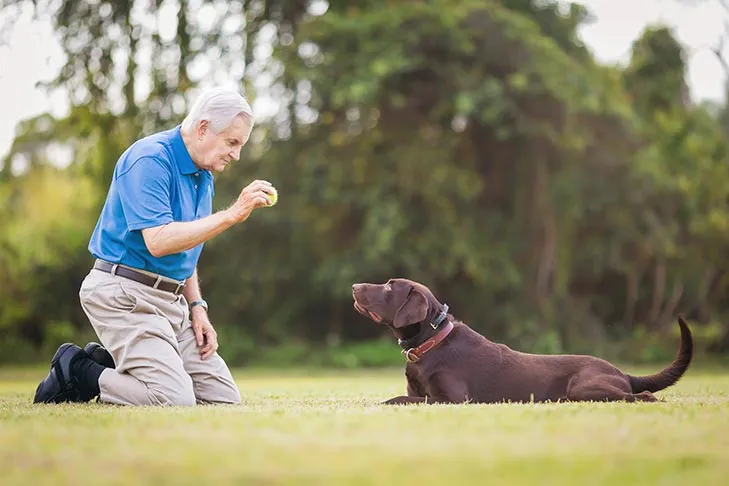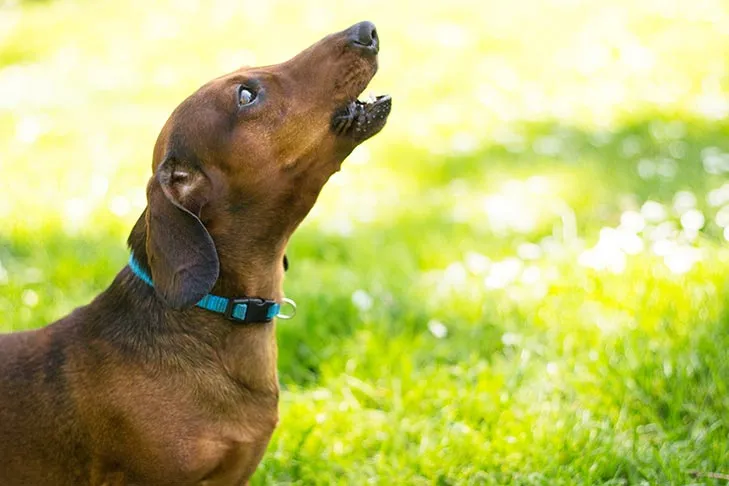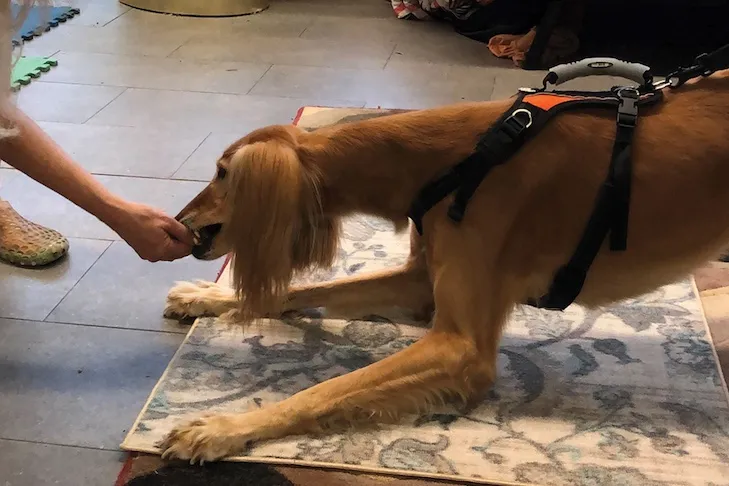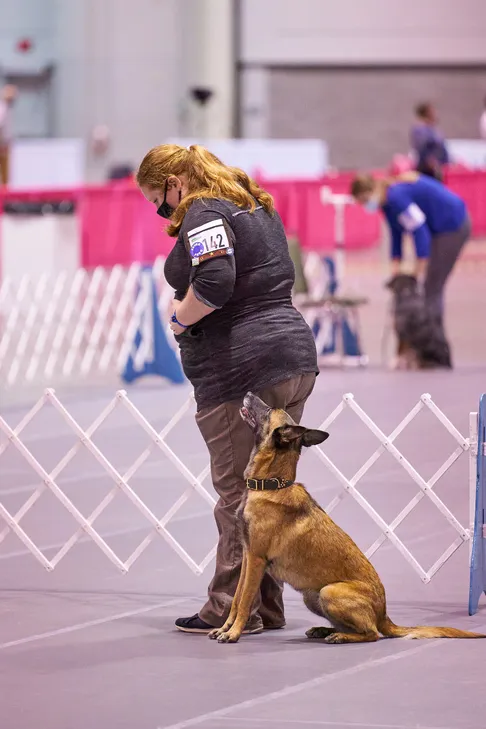Ready to dazzle your friends and family with your dog’s amazing trick repertoire? Teaching your canine companion a variety of fun tricks is a fantastic way to bond, provide mental stimulation, and challenge their abilities. Beyond the sheer joy of showcasing their talents, mastering these tricks can even contribute to earning AKC Trick Dog titles. This guide will walk you through several engaging tricks, offering clear, step-by-step instructions for successful training.
To begin your trick training journey, you’ll need a few essential tools: patience, dedication, high-value dog treats, and perhaps some favorite toys if your dog is particularly toy-motivated. For precision in marking desired behaviors, a clicker while training can be invaluable. Finally, find a quiet, distraction-free environment to maximize your training sessions.
Mastering the “Catch” Trick
Teaching your dog to catch is an exciting trick that can be surprisingly easy to implement. Start with your dog positioned directly in front of you. Gain their attention, then gently toss a treat with an underhand motion. Celebrate enthusiastically with praise if your dog successfully catches the treat mid-air. If they miss, calmly retrieve the treat before they can eat it and try again.
 THEPALMER/Getty Images Plus via Getty Images
THEPALMER/Getty Images Plus via Getty Images
Repeat this process a few times in each training session. Once your dog is consistently catching tossed treats, you can gradually introduce lightweight toys they enjoy. When they successfully catch a toy, shower them with praise and reward them with a treat. This gradual progression makes the learning process enjoyable and rewarding for your dog. You can explore more dog tricks to teach your dog easy for further inspiration.
Teaching Your Dog to Go “Under the Bridge”
The “under the bridge” trick is a charming maneuver that involves your dog crawling between your legs. Begin by sitting on the floor and forming a triangle with your raised knees. Have some highly motivating treats or toys ready. Position your dog on one side of your body, with the treat or toy in your hand on the opposite side. Entice your dog to sniff the lure by reaching it under your legs.
Slowly lower the treat or toy towards the ground, guiding it under your legs. As your dog follows the lure, they will naturally lower their body and crawl through the space. Once they have passed under your legs, offer immediate praise and the reward.
After several repetitions, you can introduce a verbal cue such as “under” or “bridge” as they begin to move. Once your dog reliably performs this trick, you can phase out the lure. Instead, use only the verbal cue, followed by praise and a treat once they’ve successfully navigated under your legs. This is a wonderful way to incorporate more common tricks to teach your dog.
The “Speak” Command: Capturing Barking Behavior
The “speak” command is most effectively taught using a technique called capturing. This involves marking a natural behavior and then attaching a cue to it over time. Have treats readily available. Whenever your dog barks naturally out of excitement, mark that bark with your chosen cue, such as “talk” or “speak,” and immediately offer a treat. Using a clicker is particularly useful here, as it precisely marks the moment of the bark, helping your dog understand which behavior is being rewarded.
 ©sanjagrujic – stock.adobe.com
©sanjagrujic – stock.adobe.com
Through repeated marking and rewarding, your dog will begin to grasp that you are encouraging them to bark. To prevent excessive barking, once your dog has mastered the trick, ensure you only reward when they bark in response to your specific cue.
Weaving Through Legs: The “Leg Weaves” Trick
Teaching your dog to weave through your legs is a dynamic trick that requires a bit of coordination. Start in a safe, open space without a leash to avoid entanglement. Stand with your legs wide apart and have your dog in front of you. Hold a treat in one hand behind your legs to guide them through and around, rather than pushing from the front. Bend your knees and use the treat to lure your dog to walk between your legs. Offer praise and a treat once they successfully pass through.
 Melounix/Shutterstock
Melounix/Shutterstock
Once your dog is comfortable with this, use another treat to guide them through your legs and around one leg until they return to the front. As you lure them, allow them to lick the treat to maintain their focus. Upon their return to the starting position, praise and reward them.
When your dog confidently follows the treat through your legs and around one side, repeat the process for the other leg. Once they can consistently be lured between and around both legs, you can start to combine the movements into a figure-eight pattern. Begin by luring them between your legs and around your right leg, then your left leg, before rewarding them. Gradually, you can fade out the treat lure, using an empty hand to guide them. Once they follow your empty hand, introduce your verbal cue, like “weave” or “legs.” With continued practice, you can phase out the empty-hand lure, and your dog will eventually associate your body language, like bending your knees, with the trick.
When they’ve mastered leg weaving while you stand still, you can progress to teaching them while walking. Start with slow, wide steps, cueing your dog to weave between your legs. As you introduce movement, reintroduce the treat lure to boost their confidence. As they gain experience, phase out the lure and increase your walking speed with smaller steps to refine the trick. Exploring top ten tricks to teach your dog can provide further valuable techniques.
The Classic “Shake Hands” Trick
Teaching your dog to “shake hands” is a charming gesture that demonstrates a strong bond. Hold your hand out to your dog. Ignore any licking or sniffing. The moment your dog paws at your hand, mark that action with praise or a clicker, and then offer a treat. Repeat this until your dog consistently paws at your hand.
Now, you can begin to extend the duration your dog’s paw stays on your hand. Wait until their paw rests on your hand for a second or two before marking and rewarding. Gradually increase this duration as your dog understands the cue.
Once your dog consistently places their paw on your hand and waits for a reward, introduce a verbal cue such as “shake” or “hello.” You can also start flattening your hand and holding it vertically, as if you were about to shake someone’s hand, using the treat in your hand as a lure. Introduce a gentle up-and-down movement with your hand before treating your dog.
Teaching “Yes” and “No” with Head Nods
This intriguing trick gives the impression your dog can answer simple questions. To teach “yes,” hold a high-value treat in a closed fist. Slowly move your fist up and down, encouraging your dog to follow the lure with their nose, which will cause them to nod their head. Reward them with the treat once they nod.
When your dog consistently follows your moving fist, try the exercise without a treat. When they nod, praise them and offer a treat from your other hand. With practice, the closed fist will become the visual cue for them to nod.
To teach “no,” use a different hand signal, such as a closed fist with your pointer finger extended upwards. Move your hand slowly from side to side. As your dog follows your hand, their head movements will appear as if they are shaking their head. When they move their head in response to your signal, praise and treat them. Eventually, the extended finger will serve as the visual cue for this head-shaking motion. This is a fun addition to the best tricks to train a puppy.
The Dignified “Bow”
Teaching your dog to bow is a graceful trick that also offers physical benefits. Start with your dog standing in front of you. Get their attention with a treat, then lure their nose down between their front legs and towards their chest. As they follow the lure, they will naturally move into a bow. Praise and reward them, then toss a treat away from them to prevent them from immediately going into a down position. Repeat this over several sessions.
If your dog tends to go into a down position instead of a bow, try lightly placing a hand or finger on their stomach just below the loin. This can signal that you are not asking for a down.
 Rachel Rehberg
Rachel Rehberg
Take a Bow: It’s good for stretching and building strength.
When your dog reliably follows the food lure into a bow, transition to luring with an empty hand, rewarding them after they achieve the bow. Once they follow the empty hand, introduce a verbal cue like “bow” or “fancy.” With consistent practice, your dog will develop the strength and coordination to hold the bow for longer durations. You can even evolve the physical cue to you bowing or curtsying.
Mastering the “Circle” or “Spin” Trick
To teach your dog to spin, capture their attention with a treat or toy. Hold the lure just above their nose and slowly move your hand in a large circle. As your dog follows the lure, they will naturally walk in a circle. Praise and reward them. After a few repetitions, when your dog consistently follows the lure in a circle, add your verbal cue, such as “spin,” “twirl,” or “around.”
Next, use the same technique to lure your dog in the opposite direction. Once they consistently follow your lure to spin the other way, add the corresponding verbal cue. When your dog reliably responds to your cue in both directions, you can transition to using the circular hand motion without a treat while using the verbal cue. When your dog spins, praise and treat them. This trick is particularly fun for easy dog tricks for small dogs.
The Playful “Peekaboo”
“Peekaboo” is a fun and practical trick, especially useful for navigating tight spaces or keeping your dog close. Stand in front of your dog, both facing the same direction. Hold a treat to capture their attention. When your dog comes forward through your legs, praise and reward them.
 David Woo ©American Kennel Club
David Woo ©American Kennel Club
After a few repetitions, introduce a verbal cue like “middle” or “peekaboo” as they move between your legs. Once your dog is positioned between your legs, use your release cue (if you have one) or toss a treat to encourage them to move out of position so you can practice again. As you continue practicing, you can phase out the treat lure, and your dog will eventually respond to the verbal cue to enter the “Peekaboo” position.
By engaging your dog in these fun tricks, you not only strengthen your bond but also provide them with valuable mental and physical stimulation. Remember to keep training sessions positive, short, and rewarding to ensure your dog remains enthusiastic about learning.
